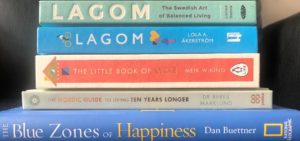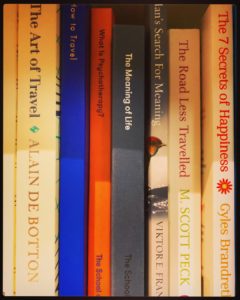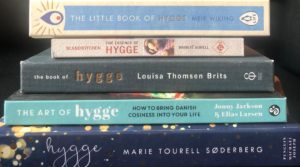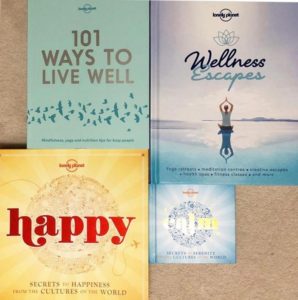15 Books about Happiness For All, Forever
Happy International Day of Happiness! Amidst the COVID-19 pandemic, let’s remember that today is the International Day of Happiness. The theme this year is ‘Happiness For All, Forever’. According to the United Nations World Happiness Report, which was published today, Finland is the happiest place (for the third consecutive year). The Finnish capital, Helsinki, is the happiest city in the world. Perhaps it is obvious that I enjoy reading articles and books about happiness. In fact, informed by such books about happiness, as well as my professional background as a Psychiatrist, I have previously written extensively about mental well-being and happiness. I have often considered happiness from different perspectives, including those of different cultures. I have discussed happiness alongside the Scandinavian concepts of hygge and lagom and the Japanese ikigai. Yet, this is the first time I’m bringing everything together.
So, without further ado, here are 15 books about happiness:
The Little Book of Lykke: The Danish Search for the World’s Happiest People
According to the United Nations World Happiness Report, Denmark continues being the second happiest place in the world. It was actually the happiest 4 years ago. So, perhaps the Danes have something to teach us about happiness. At the end of the day, they are closely associated with hygge, a concept related to wellbeing and happiness. In this book, Meik Wiking, CEO of the Happiness Research Institute in Copenhagen, distinguishes between the three dimensions of happiness:
- cognitive dimension (life evaluation – overall satisfaction with life)
- affective dimension (affect – the emotions experienced on a day-to-day basis) and
- eudaimonia (sense of purpose)
You can read more about Scandinavian books about happiness, hygge and lagom here.

The Blue Zones of Happiness: Lessons from the World’s Happiest People
In this book, Dan Buettner also explores the three dimensions (or strands) of happiness. He considers those in three different countries, which are often heralded as the world’s happiest places (the so-called blue zones of happiness): Denmark, Costa Rica and Singapore. For instance, he explains how the Danes score high on the purpose strand, as well as the pleasure (experienced happiness) and pride (evaluative happiness) ones.
For the Singaporeans, happiness is also closely related to purpose, meaning and fulfillment. At the same time, the Gallup World Poll consistently ranks this small Asian country high for life satisfaction. The extraordinary social support, an important part of their culture partially explains why the Costa Ricans are so happy.
Happiness: How to Get Into the Habit of Being Happy
In ‘Happiness’, Gill Hasson debates the question ‘can money buy happiness?’; she then writes that experiences can last longer than things. Spending money on things can certainly lift our mood. However, once the initial thrill that follows a purchase wears off, things no longer contribute to our happiness. In contrast, experiences often do, even years later. Happiness can linger on for a long time after the experience is over. This is because experiences can create happy memories; it is the recollection and reliving of those memories that can fuel happiness long afterwards. Furthermore, even beforehand, experiences can contribute to happiness. For example, planning and anticipating an experience, such as traveling or going to a concert, often has that mood-boosting effect. So, by looking forward to or reminiscing an experience, you can make yourself a bit happier. By actively reflecting on that experience, you can enhance your happiness even more.
Unlike the previous authors, Hasson, a teacher, trainer and writer with 20 years of experience in the area of personal development and known to combine CBT principles with a mindfulness-based approach, considers happiness from two (rather than three) viewpoints: a short-lived pleasure versus a general sense of wellbeing. She discusses Aristotle’s distinction of happiness into hedonic happiness (small pleasures) and eudaemonic happiness (a sense of meaning, purpose and fulfillment).
Aristotle’s Way: How Ancient Wisdom Can Change Your Life
At the beginning of this book, Edith Hall follows a similar approach to the previously mentioned authors, and also distinguishes between three approaches to the definition of happiness. But, ‘Aristotle’s Way’ is not a book about (just) happiness, but goes well beyond that.
Hall explores a large part of the Greek philosopher’s work: ethics, ideals, and ideas that are not only relevant to our lives and the modern world but have influenced humanity through the centuries. Traces or chunks of Aristotle’s thinking can be found from the United States Declaration of Independence to Sigmund Freud of psychoanalysis, and from modern philosophers (Immanuel Kant, Karl Marx, and Friedrich Nietzsche) to writers (Leo Tolstoy) to mention only a few. At the same time, Hall skilfully discusses and explores Aristotle’s ideas in different contexts: from ancient Greece and philosophy to religion, and from twentieth-century culture (especially literature and cinema) to daily life (including her personal).
Of course, happiness continues to play a central role in Hall’s writing and crops up in different chapters. For example, in the chapter about ‘Self-Knowledge’, she talks about the ‘routes to happiness’; she argues that happiness can be learned through practice (I agree; like playing a musical instrument, happiness is a skill that can be practiced and learned). In ‘Leisure’, she explains how activities of leisure can also contribute to one’s happiness (in addition to purposeful, meaningful activities – the cornerstone of happiness, according to Aristotle). Then, in the final chapter ‘Mortality’, she writes about our ‘free will, agency, and a potential for great happiness’, whilst discussing concepts such as mental illness, death, suicide, and religion.
You can read more about ‘Aristotle’s Way’ here.
Buddha’s Brain: The practical neuroscience of happiness, love & wisdom
Just coming across the title of this book co-authored by neuropsychologist and meditation teacher Rick Hanson and neurologist Richard Mendius was enough to spark my interest. Despite its title, however, this book is not about religion, Buddha or Buddhism. Or about mindfulness or meditation either (even though these eastern practices feature on the book). It is, nonetheless, about neuroscience and how experiences can shape one’s brain, and contribute to one’s happiness.
You can read more about ‘Buddha’s Brain’ here.
Happiness: A Very Short Introduction
In this book by Daniel M. Haybron, I read about ‘the hidden face of happiness’. The author beautifully explains the role of the unconscious into our happiness and wellbeing. He then talks about mood propensity and the non-conscious aspects of our emotional world, which he links with our temperament.
As a Psychiatrist, I strongly believe that happiness is a skill that can be practiced and learned. This view has been embraced from Aristotle to Buddhists, and from modern-day psychologists to bloggers, entrepreneurs and influencers. Yet, it can easily be misinterpreted. When I’m saying that happiness is a skill to be cultivated, I am not talking in the context of clinical depression (or other severe mental illness). For sufferers with clinical depression need treatment (usually psychological therapy and/or medication). But, for the rest of us, the view that happiness is a skill (neither a given nor simply an option) is empowering; at the same time, however, it puts the responsibility on the individual. For nature (genetics), temperament/mood propensity, early life events/nurture and later life circumstances all contribute to our emotional responses, we still have the power and the responsibility (to ourselves) to work towards a happier life.
Haybron also mentions the ‘negativity bias’: how we have the natural tendency to focus on the negative things in our environment more than on the neutral or even positive ones. Our brains have simply been wired this way. Yet, we can overcome this inherent status quo; this is exactly why I consider happiness a skill we can practice and learn.
Let Me Tell You a Story: Tales Along the Road to Happiness
This is one of the few books by Argentinian gestalt psychotherapist, psychodramatist and writer Jorge Bucay that have been translated into English. It consists of a good 50 chapters, each one containing a story. Bucay writes from the perspective of Demián, a young man embarking on a psychotherapy journey. Demián tells us the stories that his therapist – Jorge – told him during the therapy sessions. Not all these stories are from the author’s imagination; some have been inspired by and adapted from tales (old and new), poems and books. Both the individual stories and the book as a whole are inspiring and full of wisdom and take-home messages worth reflecting on.
Another strength of this book (and Bucay’s writing in general) is the simplicity in which he writes; this makes for a pleasant (and easy) read although what he writes about has really deep meaning. Moreover, even though he lives and practices in Argentina, his writings transcend frontiers and are of relevance to readers across the world, which explains his popularity in different countries.
‘Let Me Tell You a Story’ (original title: ‘Déjame que te cuente’) is by no means a self-help book. And, of course, is no substitute for therapy. Despite its title, it is not a shortcut to happiness either. Yet, it can have therapeutic value in that it creates a space to allow the readers to reflect on their own emotional world. In that sense, like Demián, they can embark on their own inner journey and move along the arc.
You can read more about ‘Let Me Tell You a Story’ here.
The 7 Secrets of Happiness: An Optimist’s Journey
What an awesome title for a book! Happiness, optimism, and a journey, all in the same sentence. In the introduction, Gyles Brandreth writes about his personal journey looking for happiness, a journey that took him to different places around the world where he met some very remarkable people: the Pope’s exorcist at the Vatican, Buddhist monks in Cambodia, Archbishop Desmond Tutu in South Africa, Quentin Crisp in New York, and the Queen of Denmark in Copenhagen.
But it was in Dublin where he discovered the 7 secrets of happiness thanks to the late Dr Anthony Clare, Professor of Psychiatry at Trinity College, widely known for his radio interviews: In the Psychiatrist’s Chair. In fact, Brandreth says, he and Clare were planning to write together a book about happiness, but Clare sadly died. Reflecting on his relationship with Clare, Brandreth writes that when he first met the famous psychiatrist, he asked him the elixir of happiness, the 7 secrets of happiness. He then reflects on their discussions, which subsequently led him to come up with the answer to his initial question.
Reflecting on Brandreth’s 7 secrets of happiness, I realize that they are very much in keeping with my own recommendations (or tips) for mental health and wellbeing.
You can read more about ‘The 7 Secrets of Happiness’ here.

Hygge: The Danish Art of Happiness
Written by Danish actress Marie Tourell Søderberg, this book may seem like yet another book about hygge, the Danish concept that has taken the world by a storm. What sets it apart, however, is that Marie explores hygge from a personal viewpoint rather than that of an expert. The book features practical tips and recipes, but also narratives and even dialogues (rather than just quotes) by some Marie’s colleagues and compatriots, such as actor Lars Mikkelsen and author Christina B. Kjeldsen.
You can read more about Scandinavian books about happiness and hygge here.

The Atlas of Happiness: the global secrets of how to be happy
Stumbling across Helen Russell’s latest book, I immediately knew I wanted to read it. On the one hand, I have always been fascinated by maps, geography and travel. On the other, as a Psychiatrist, I help people in the pursuit of their happiness, and guide them through the long and winding road of life, usually at times when they’re the least happy.
This book was inspired by the background work that Russell did for ‘The Year of Living Danishly’. However, this time she doesn’t stay in Denmark, but goes beyond hygge, and she travels all around the world. In her own words, ‘the result is a catalog of cultural customs to give a horizontal perspective on happiness and what it means to live a good life around the world’. She visits thirty countries (or regions), some of which are officially among the happiest on Earth, whereas others fall far behind. For each of these countries, she discusses a concept (or two) originating from there.
You can read more about ‘The Atlas of Happiness’ here.
Happy: Secrets to Happiness from the Cultures of the World
In the introduction to this book, I read that:
‘it’s some of the most basic aspects of life found in every culture that bring us the most joy – connection, mindfulness, gratitude, play’
As a Psychiatrist, I’ve learned how important these aspects are for our wellbeing. However, despite being a travel enthusiast, I had not previously considered these very important aspects in the context of traveling. Reading this book, I put two and two together and realized that traveling and the subsequent contact with different cultures can teach us so much about wellbeing, and help us live happier lives.
The book discusses 55 cultural experiences from 43 countries of the world. By ‘cultural’ I mean that these experiences are embedded in the cultures and traditions of these countries. These are experiences that can teach us a lot about happiness, and by distilling their core messages and secrets, we can introduce an extra layer of happiness to our everyday lives (without necessarily having to travel to those far-away places).
You can read more about the ‘Secrets to Happiness from the Cultures of the World’ here.

The Nordic Guide to Living 10 Years Longer: 10 Easy Tips to Live a Healthier, Happier Life
As the title suggests, Dr Bertil Marklund, a doctor and researcher at the Gothenburg University, shares ten tips that promise not only a happier but also a healthier life. As a Psychiatrist, I agree with this approach. In fact, I believe that happiness and mental well-being are multi-factorial, and closely related not only to mental but also to physical health.
Dr Marklund talks about the benefits of physical exercise (Tip 1: Movement Rejuvenates The Body), good sleep (Tip 3: Sleep Fortifies), sunlight exposure (Tip 4: Sun – but not too much), healthy diet (Tip 5: Eat yourself Healthy) and good oral health (Tip 8: Oral Health gives general Health). He shares tips on how to rip these benefits, but also strategies on combatting stress (Tip 2: Time for Recovery) and keeping weight in check (Tip 7: Keep your Weight in Check).
You can read more about Scandinavian books about happiness here.
Ikigai: The Japanese secret to a long and happy life
In this book, the authors Hector Garcia and Francesc Miralles discuss the Japanese concept ikigai and then take the reader through other related concepts and values, including ichigo ichie and flow, as well as resilience and mindfulness. They also discuss wabi-sabi, another Japanese concept about accepting the fleeting and imperfect nature of the world and life.
However, the main difference between this book and most books about ikigai (or happiness even) lies in the emphasis that Garcia and Miralles place on longevity. They pay particular attention to Okinawa; this Japanese island is often claimed to be the place where people live longer than anywhere else on planet Earth. As the title suggests, they try to uncover the Okinawans’ secret to longevity, whilst exploring the concept of ikigai.
You can read more about ikigai here.
The Architecture of Happiness
‘The Architecture of Happiness’ is a book by Alain de Botton, one of my favorite authors. Unlike the other books on this list, this is a book less about happiness and more about architecture.
The Swiss-born British author has also written (or co-written) many other interesting books; these include the travel-related ’A Week at the Airport: A Heathrow Diary’ and ’The Art of Travel’.
Unhappiness can stem from having only one perspective to play with.
Alain de Botton (from ‘The Art of Travel’)
As a side note, I would like to mention that Alain de Botton co-founded The School of Life in 2008. This is a global organization has its headquarters in London; they offer a range of services, including classes, workshops, and events. They also offer therapy services, publish books (i.e. ‘What is Psychotherapy’, ‘The Meaning of Life’ and ‘How to Travel’), and upload educational videos on YouTube. A common denominator of all these services is the focus on emotional intelligence and wellbeing.
The Happiness Advantage: The Seven Principles that Fuel Success and Performance at Work
Shawn Achor is an author, with a background in Positive Psychology and happiness research. His TED talk ‘The happy secret to better walk’ is one of the most-watched of all times.
In ‘The Happiness Advantage’, he discusses ‘the seven principles that fuel success and performance at work’; he explains that these principles are patterns that can predict success and achievement, and can therefore be applied in the workplace or in academia. In his own words:
‘isolating seven practical, actionable principles that have been tried and tested everywhere from classrooms to boardrooms, stretching from Argentina to Zimbabwe, he shows us how we can capitalize on the Happiness Advantage to improve our performance and maximize our potential’
In other words, starting from the field of Positive Psychology, Achor goes beyond (individual) wellbeing and brings happiness into work and business; he views happiness as an essential ingredient for increased productivity and work performance, and ultimately success (rather than the other way round). This wider scope is certainly worth reading about, which is exactly what drew me into ‘The Happiness Advantage’.
At the beginning of the book, drawing from happiness research, Achor defines happiness as:
‘the experience of positive emotions – pleasure combined with deeper feelings of meaning and purpose’
He also makes reference to the three components of happiness: pleasure, engagement, and meaning, as well as to Aristotle’s eudaimonia. He then re-defines happiness as:
‘the joy we feel striving after our potential’
This link between happiness and success is essentially the premise of this book.
As a Psychiatrist, I strongly believe that both pleasurable and purposeful activities are essential ingredients for a balanced life. I have previously written about a holistic approach to one’s mental wellbeing, which includes a combination of such activities, as well as regular exercising, meditating, gratitude lists, and other practical ways largely informed from the fields of Positive Psychology and Neuroscience. Reading this book, I realize that Achor and I have a similar approach to wellbeing.
But, how does this holistic approach can contribute to increased productivity and work performance, and success? According to Achor:
‘allowing ourselves to engage in activities we enjoy can actually greatly enhance our performance at work’
Achor also describes how re-training our minds to have a positive outlook can increase our happiness (confirmed by Positive Psychology and Neuroscience research), but also fuel our success. He explains how gratitude and optimism, along with happiness, can improve wellbeing, as well as work performance. He then provides some practical recommendations on how to capitalize (to use one of his catchphrases) on that. For example, he advises us to make a daily list of three good things (in one’s life, job or career). I personally find this daily gratitude list an excellent habit that can increase one’s wellbeing; it seems that it can also enhance work performance and fuel success.
So, it seems that the recipe and the ingredients for improved wellbeing on the one hand and increased productivity and work performance on the other are the same. This essentially proves that optimal wellbeing is a key ingredient for success. It emphasizes the importance of improving our wellbeing for the sake of both our personal happiness and our success in the workplace.
Last but not least, I would like to note that Achor views adversity, struggling and failure not as stumbling blocks but as stepping stones to greatness. Like the rest of the book, this view appears to have been informed by his Psychology background; it is in keeping with Aristotle’s view that we are not passive recipients of happiness (or unhappiness), but our happiness largely depends upon ourselves and our actions.
‘Happiness depends upon ourselves’
Aristotle
Further reading
You can read the World Happiness Report here.
Acknowledgements
I’d like to thank Gill Hasson, Edith Hall, Rick Hanson and Shawn Achor for sending me copies of their books for read and review. I’d also like to thank Daniela Petracco and Europa Editions for sending me a copy of Jorge Bucay’s ‘Let Me Tell You a Story: Tales Along the Road to Happiness’ for read and review.
Alex
(the Traveling Psychiatrist)